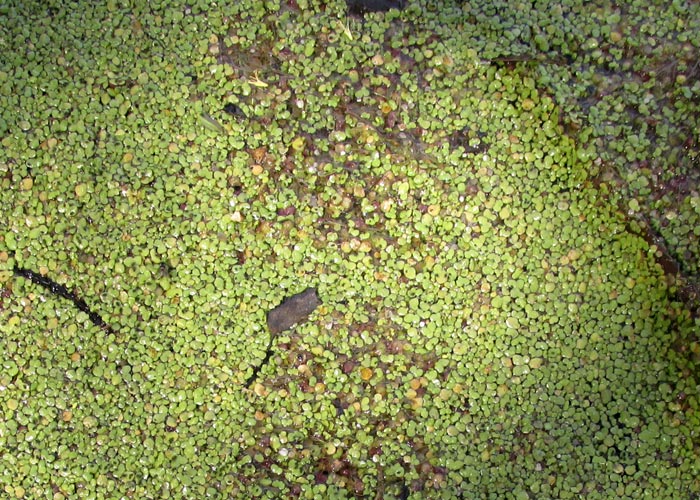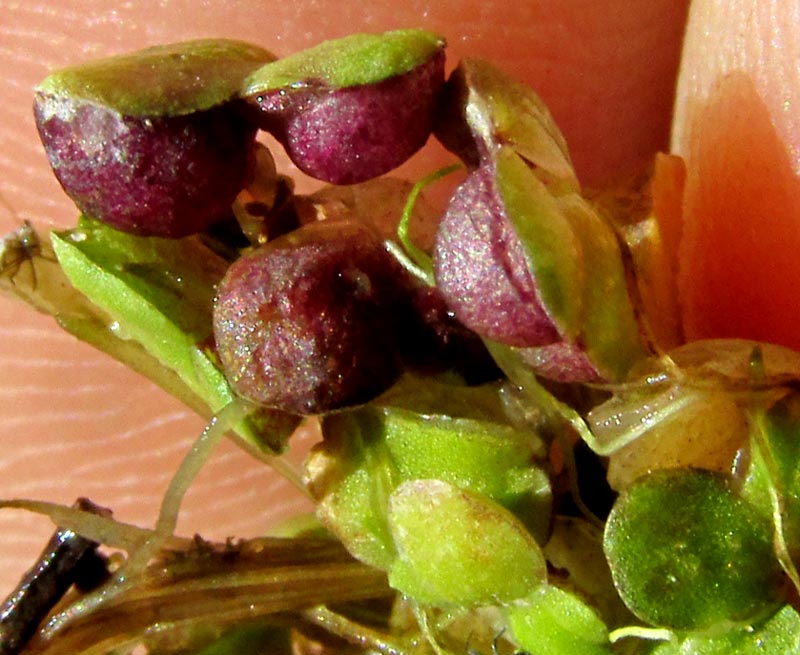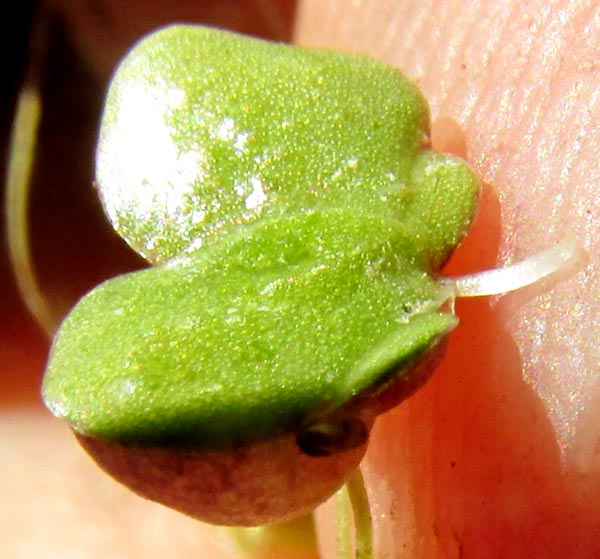Excerpts from Jim Conrad's
Naturalist Newsletter
entry dated April 1, 2022, issued from near Tequisquiapan, elevation about 1,900m (6200 ft), ~N20.57°, ~ W99.89°, Querétaro state, MÉXICO
FAT DUCKWEED

Now during the latter, drier, hotter, sunnier part of the dry season, a house-sized pond dug so deep that it still has water in it, though few others in the area do, is carpeted with tiny duckweed, as shown above. The word "duckweed," however, applies to a whole group of free-floating, aquatic plants, consisting of four genera, all of which occur in this upland, arid central Mexico region known as the Bajío. Earlier this group of duckweed genera resided in its own family, the Duckweed Family, the Lemnaceae, but with genetic sequencing they've been demoted to form just a subfamily of the much larger Aroid Family, the Araceae. That family includes such famous and often ornamental species as jack-in-the-pulpits, elephant ears, anthuriums, monsteras and Skunk Cabbage -- plants very different in outward appearance, but with flowers sharing surprisingly similar basic structure.
So, which kind of duckweed do we have here? Dipping up a handful, it was easy to eliminate two genera, just seeing what's shown below:

Two genera, Lemna and Spirodela produce roots, while two, Wolffia and Wolffiella, don't. In the picture, the threadlike, mostly cream-colored items are roots, though normally they root in water, not mud. Also in that picture, the hemispherical bulges at the bottom of the green "fronds," as duckweed leaves often are called, constitute an important fieldmark for determining the species, because only a few duckweed species produce such bulges. So, of the two remaining genera, which do we have? The answer is apparent in the picture below.

Of the rooted genera, Spirodela usually bears more than one root per frond, sometimes up to 21 or so, but Lemna makes only one root. All of our fronds produce just one root. Therefore, our plants belong to the genus Lemna, the "true" duckweeds.
About 13 Lemna species are recognized worldwide. Nine occur in North America, and in our Bajío region five have been documented. However, for me, it's still a challenge to know which species we have here. I find the technical literature a little obscure on some details, and certain disagreement among the experts. Our plants' main field mark, the bulging bottoms of the fronds, is our most important hint. The species famous for its bulging bottom is LEMNA GIBBA, sometimes called the Fat Duckweed because of that bulge. However, another species occurs in our area, Lemna obscura, and while the Flora of North America describes that species as often bulging on the bottom, the Flora del Bajío indicates that it does not.
The Flora del Bajío, says that Lemna obscura fronds are symmetrical at their bases, while Lemna gibba fronds are asymmetrical, while the Flora of North America is silent on the matter. Our plants are asymmetrical at their bases. The Flora of North America says that on Lemna gibba the red coloring on the bottom bulge spreads from the margin, while on Lemna obscura, coloring emerges from the point of root attachment. The Flora del Bajío is silent on the issue. Below, red coloring appears to spread from the frond margins, so that's another vote for Lemna gibba.

And that's where it's staying for me unless more information comes along. On duckweeds with bulging bottoms, asymmetrical fronds with red coloring spreading from frond margins below means Lemna gibba, sometimes called Fat Duckweed, we'll say.
Fat Duckweed occur almost worldwide where it doesn't get too cold. Often it lives in quiet, eutrophic waters, which are waters rich in nutrients, thus supporting a dense plant population, the decomposition of which kills animal life by depriving it of oxygen. Our little pond looked very eutrophic.
entry dated June 25, 2022, issued from near Tequisquiapan, elevation about 1,900m (6200 ft), ~N20.57°, ~ W99.89°, Querétaro state, MÉXICO
A FLOWERING FAT DUCKWEED
Whenever I find a duckweed population I look for flowering plants. Duckweed produce the world's smallest flowers, after all, and I've never seen one in real life. Usually duckweeds reproduce by budding but, especially when under stress, they sometimes flower and produce seeds. For that reason, to find flowers, I always look along the waterbody's edge where individual duckweeds may have come ashore and are slowly drying out, causing stress. However, the flowering duckweed I finally found wasn't one of the washed-up ones, but one a finger-length from shore. Maybe the washed-up ones issue chemical messages of their plight, warning neighbors they may need to flower, I thought, for nowadays all kinds of new findings are being published on how organisms communicate in this manner and others. Below is the flower:

I read species in the duckweed genus Lemna normally produce only one flower per body, or frond, and that the flower makes no calyx or corolla. It consists of two stamens and a single pistil, the pistil composed of the usual roundish ovary, slender style and blunt stigma. The stigma -- where pollen is supposed to land -- is concave.
With this in mind, It seems right to interpret what looks penis-like in the picture as two stamens cohering to one another because of hydrogen bonds in the films of water covering them. What appears to be a split, yellow head of one organ, must be two anthers, also cohering. I can't say where the female part is. Typically in flowers with both male and female parts, parts of one gender mature at a different time from the other, avoiding self pollination; Maybe the pistil hasn't emerged yet.
By the way, out of focus at the picture's bottom, that's a Brazilian Watermeal, Wolffia brasiliensis, budding, thus altogether avoiding this whole flowering business. However, if it were to flower, its blossom would be even much smaller than what's in our picture.